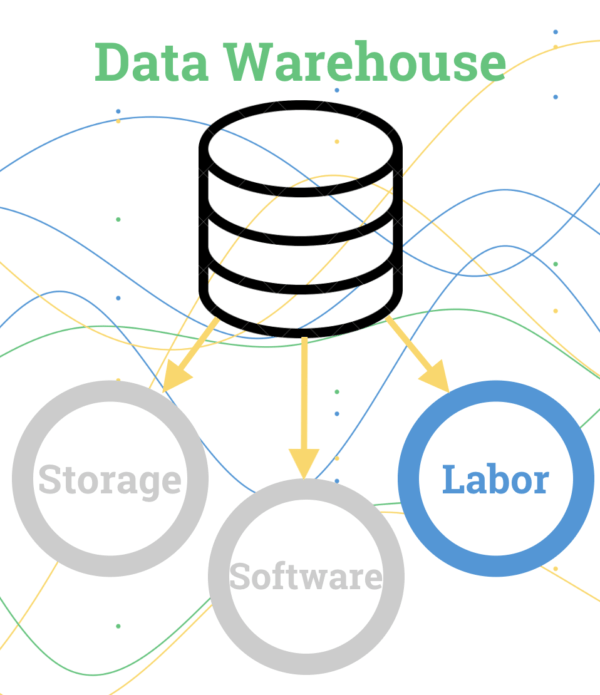In our Data School tutorial “Basics of Building a Data Warehouse”, we identify the benefits of using a data warehouse and introduce the basic structure needed to build one. The structure consists of three different components: a storage mechanism, operational software, and human resources. In this tutorial, we’ll break down the human resource aspect of a data warehouse.

Labor is the management component of the data warehouse, something that’s absolutely essential for having a working solution. Warehouses stored on an in-house server require human labor to be fully functional. Storing your warehouse on the cloud, however, requires less labor. Since the cloud is handled by a third party vendor, it’s their responsibility to perform needed repairs and upgrades to servers and hardware, and doesn’t cost your business any time or money.
While there are some advantages to in-house servers, they require labor from people with great knowledge and skill. To keep your warehouse functional, you’ll need to hire an Information Systems Manager, Backend Developer, and Database Architect, and for the visualization portion of your warehouse, a Data Analyst. Let’s further discuss each position including job responsibilities and salary.
Information Systems Manager
An information systems manager is responsible for overseeing the team that runs your warehouse and keeps all systems in check. These professionals typically hold at least a bachelor’s degree and are the planners and directors of all business activities that relate to computers, including data warehouses. Generally, an information systems manager is in charge of:
- Managing the daily activities of the team responsible for data warehouse systems.
- Overseeing data design and the creation of database architecture and data repositories.
- Establishing proper balance between front-end systems and back-end processing.
- Installing processes for auditing data warehouses and ensuring data quality.
- Giving progress reports to upper management.
- Ensuring that department goals are met and adhere to approved budgets.
As the “boss” of the data warehouse, an information systems manager plays a crucial role. Because of their high importance, they have one of the highest average yearly salaries of the bunch — $92,306.
Backend Developer
A backend developer is responsible for installing the Extract Transform Load (ETL) software and making sure it works correctly with your storage system. These professionals hold at least a bachelor’s degree and are primarily required during the development, quality assurance, and transition to production phases in the data warehouse journey. Generally, a backend developer is in charge of:
- Designing, developing, and supporting new and current ETL processes.
- Upholding industry standards and best practices to boost data loading speeds to and from different sources.
- Providing support to the business’s overall goals in the usage and consumption of information through their data warehouse.
- Documenting technical needs for ETL processes and databases, and ensuring optimal technical infrastructure is utilized.
This position involves completing important data integration projects and requires using best practices and having experience with implementation. The average yearly salary for a backend developer is $90,450.
Database Architect
A database architect is responsible for developing and implementing the best solution for merging the databases within your data warehouse. These professionals hold at least a bachelor’s degree and use their skills to solve business problems and find solutions to issues in databases. Generally, a database architect is in charge of:
- Determining database structural requirements by evaluating current systems.
- Developing database solutions for merging.
- Installing database systems within the warehouse.
- Maintaining individual database performance by identifying and resolving any and all problems.
- Helping protect the integrity and security of the company database.
- The integration of databases to the warehouse structure is why a database architect is essential for building a data warehouse.
Their extended abilities to refine system performance and functionality are an added bonus; their important and wide skill set make their average yearly salary around $105,723.
Data Analyst
A data analyst is responsible for analyzing and visualizing the data from the warehouse to help your business make valuable insights. These professionals typically hold at least a bachelor’s degree and use their skills to help companies make better business decisions through data. Generally, a data analyst is in charge of:
- Interpreting data and analyzing results using statistical techniques.
- Providing ongoing reports of findings.
- Developing data analytics strategies that optimize statistical efficiency and quality.
- Identifying, analyzing, and interpreting trends or patterns in datasets.
- Filtering data by reviewing computer reports, printouts, and performance indicators to locate and correct code problems.
- Working with management to prioritize business and information goals.
This position is centered on the visualization side of the data warehouse and isn’t essential for the actual structure. Nevertheless, having a data analyst on your warehouse team can turn something purely mechanical (data) into something meaningful (learnings and insights). The cost of having a data analyst isn’t nearly as much as some of the other required positions — $65,470 is the average yearly salary.
Conclusion
Once the basic structure of your warehouse (storage and software components) has been designed, it’s time to get your plans into action using human resources. If your warehouse is cloud-based, fewer human resources will be required; only a data warehouse manager and a data analyst are needed. If your warehouse is using an in-house server, consider hiring an information systems manager, backend developer, database architect, and data analyst. Without having the essential human resources to set up and maintain your warehouse, your efforts in building a warehouse are futile.
References:
- https://swz.salary.com/salarywizard/Data-Warehousing-Manager-Job-Description.aspx
- https://jobdescriptionandresumeexamples.com/data-warehouse-developer-job-description-example/
- https://learn.org/articles/Database_Architect_Jobs_Your_Career_and_Salary_Questions_Answered.html
- https://resources.workable.com/data-analyst-job-description